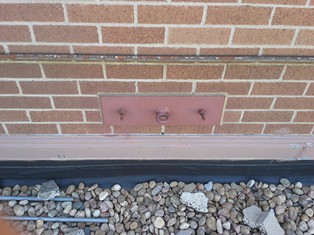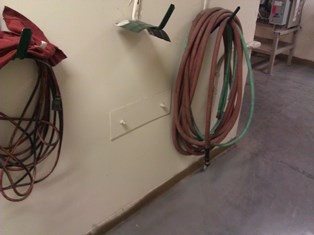An Inside Look at Why Fall Protection Anchors Must be Tested

by Zachary Forster, P.E.
Fall protection! When you put on your harness, tie off to a fall protection system, and step to the edge of the roof on a 20 foot tall building, do you know that you are truly safe? Or is this maybe just a false sense of security that you have been lulled into? Would you feel different if this were a 200 foot tall building?
As we all know, the components of a complete fall protection system are the user’s personal fall protection equipment and a suitable anchor or lifeline to connect it to. If the system is properly designed, constructed and used, it will ensure that you will walk off the jobsite at the end of the day safe and sound. As a user, you can only control the “use” aspect of the system so a great deal of responsibility is on you to ensure your own safety. If you are a gambler, you can take your safety on faith. However, those who do not want to rely on dumb luck need to know their fall protection system. First, the simple stuff: your body harness and lanyard. They should be purchased from a reputable source with readily available design and testing data from the manufacturer.
Utilizing your Fall Protection User Training, you should be able to perform a visual inspection of the equipment to check for damage or excessive wear. If all looks good, you should feel comfortable that your personal fall protection equipment will do its job. On the other hand we have the anchor portion of the system – this is not so easy. You can look for visible signs of damage or corrosion, but the truth of the matter is that in most cases you have no idea what is behind or underneath the anchor itself. It is in these areas where corrosion hides and maintenance tends to neglect. The truth of the matter is that if the anchor was not designed and installed properly, no amount of maintenance can make it safe to use! You may be thinking the anchor is fine and dandy because that steel beam over there is “big”, or that wall looks “solid” . . . there is no way that it won’t hold 5,000 pounds! This may be true, but as you stand there looking at the “big” steel beam ask yourself this: what is holding the beam in place? Okay there is a steel column at both ends, but what are they attached to? If you don’t know, how can you really be sure that “big” steel beam isn’t going to follow you over the edge of the roof if you fall? OSHA requires that all permanent fall protection anchors must be tested upon installation and be visually observed annually if they are to remain active. The fact of the matter is that many property owners simply do not know about these requirements as many building anchors are used daily which have never been tested or inspected. This puts you at risk of injury, and the property owner and your employer at risk of a hefty lawsuit if something were to go wrong.
We were recently involved in a project which involved the load testing of existing fall protection anchors around the perimeter of the mechanical penthouse. The anchors were installed on the outside face of the brick veneer and consisted of a steel eye welded to the center of an 18”x6”x 1/8” thick steel plate. The plate was bolted to the wall with two ½” diameter threaded rods and nuts at both ends. On this particular structure, we could observe that the other end of the connection inside of the penthouse was identical to the connection on the outside.

Existing anchor’s outside and inside of mechanical penthouse.
From the picture to the left, you may be thinking it looks like someone clearly put some thought and effort into installing these anchors so they must have been designed and installed properly. No rust is apparent and the wall appears “solid” . . . why do they need to be tested??? The reason we were asked to test the anchors is because someone didn’t feel like gambling as they prepared to hang off the side of the building and asked the correct question “can I get a copy of the latest testing and inspection reports?”
As it turns out there was no record that the anchors had ever been tested or inspected, and more disturbing that they may have never been designed either. Fortunately in this case, the property owner and contractor were well aware of the OSHA requirements and requested the anchors be tested before use. Armed only with a single architectural section of the penthouse wall, we felt it would be prudent to perform a structural investigation prior to performing any testing. During this investigation we discovered that the two threaded rods were installed adjacent to the light gauge steel studs at most locations. Running a computer modeled analysis of this configuration yielded results which confirmed that not only were the anchors not suitable for their intended use, but that testing them could potentially damage the building!
Since the existing anchors were determined to be inadequate, new anchors were designed and installed and the old anchors removed and/or taken out of service. During the testing of the new anchors, we were asked to test one of the existing anchors in a location that a new anchor could not be installed due to equipment conflicts inside the building. The test was halted at only 1400 pounds as the outside plate had already deflected ½ inch with this minimal load applied to it!

Picture during testing of existing anchor.
The topic of fall protection anchors is cussed and discussed all the time, but we still have individuals who are either uninformed regarding the OSHA standards or they simply don’t care. The anchor may look “big”, and that wall may appear “solid”, but the only way to know with certainty that it is safe is through proper testing and annual observation. As a user, you need to be cognizant of your own safety and simply ask for the latest fall protection anchor testing or inspection report before you go trusting your life to it. This will provide you with peace of mind, and you may educate someone else about the OSHA standards in the process which may save another life down the road.
You can find an online version of the article at: http://www.dhglabe.com/trust-the-math-for-your-eyes-may-be-deceived/
Beginning his career in 2006, Zach has engaged in a diverse spectrum of work ranging from building and temporary structure design to natural disaster damage assessment. He has expertise in scaffolding, formwork, and falsework design, bridge demolition and erection, designing and testing personal fall protection equipment, roof davit systems and manufacturers equipment. Zach received his Bachelor of Science degree in Civil Engineering from Colorado State University in 2006. Zach completed his engineering internship designing residential and light commercial buildings in Loveland, CO and joined the DH Glabe & Associates team in 2011. Zach has a special interest in Forensic Engineering and building repair as he believes that studying old buildings and structural failures provides an engineer the opportunity to become a better designer by learning from both our mistakes and our achievements. Zach is a licensed Civil Engineer in Alabama, Alaska, Colorado, Maine, Mississippi, Missouri, Montana, New Hampshire, North Dakota, Ohio, Oklahoma, Oregon, Rhode Island and Puerto Rico. He is also a licensed Structural Engineer in Vermont.
Subscribe Today!
Stay-in-the-know and subscribe to our blog today!